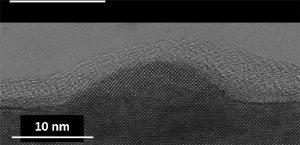Aug 17 2009
Electrons that are trapped in very small structures of only a few nanometer, demonstrate fascinating features. These could be useful for novel computers or semiconductor lasers. Researchers from the University of Sheffield, the Ecole Normale Supérieure in Paris, and the Forschungszentrum Dresden-Rossendorf research center measured for the first time the exact lifetime of excited electrons and published their findings in the journal "Nature Materials".
 TEM picture of a quantum dot on a gallium arsenide layer. On top is a glue layer due to TEM preparation only (picture: University of Sheffield)
TEM picture of a quantum dot on a gallium arsenide layer. On top is a glue layer due to TEM preparation only (picture: University of Sheffield)
For many applications it is highly desirable that electrons, excited to a higher energy state, take a long time until they relax back to the ground state. This is a key ingredient for any kind of laser, but also would be desirable for modern applications in quantum information processing (where also the phase coherence should be conserved).
Starting about 20 years ago, researchers have been able to grow so-called quantum dots on standard semiconductor substrates, such as gallium arsenide (the material used e.g. in CD players). These dots are tiny pyramids, containing typically between 1,000 and 10,000 atoms of a different semiconductor material than the substrate in which they are embedded. As the volumes of the dots are extremely small, the electrons follow quantum-mechanical rules and are supposed to enter only sharply defined energetic states. Furthermore, the electrons are confined in all three directions, and thus they represent a kind of artificial atom, which could become a building block of revolutionary future (opto-)electronic devices.
At that time it was predicted that excited electrons should live for a very long time in these quantum dots, since they hardly find any ways in which to lose their energy. For many years it has remained a puzzle why such long lifetimes, also called the "phonon bottleneck" at that time, were never observed. Further work a few years back has shed new light on this issue: Due to the strong confinement of the electrons, the well known theory describing the loss of energy of electrons to lattice vibrations (phonons) is not applicable, since the electrons form entities which are strongly coupled with phonons, so-called polarons.
Now, taking seriously the predictions of this new theory, researchers from University of Sheffield, UK, Ecole Normale Superieure in Paris, France, and Forschungszentrum Dresden-Rossendorf in Germany have designed quantum dots which allow a rigid test of the theory over a wide parameter range. By making the separation of the energy levels in the quantum dots significantly smaller than the energy of the most important lattice vibration, they were able to observe lifetimes which differed by a factor of thousand for an energy separation which only varied by a factor of two. In numbers, the relaxation time increased from few picoseconds (a millionth of a millionth of a second) to nanoseconds (a thousandth of a millionth of a second), when reducing the electron energy only by half. These long lifetimes, although being of different origin than the originally proposed "phonon bottleneck", could open a wealth of applications, in particular for terahertz (THz) devices based on quantum dots. The reason for this lies in the fact that the relevant energy level separation is of the order of 10-20 milli-electronvolt (meV), which can be expressed as a frequency of a few THz.
In order to accurately measure these lifetimes, the researchers used a unique type of short-pulse terahertz laser, a so-called free-electron laser (FEL), located at the Forschungszentrum Dresden-Rossendorf. In this free-electron laser high-intensity infrared and terahertz pulses can be generated at a wide range of wavelengths (or frequencies) to fit many kinds of scientific problems in physics, chemistry and biology. In this collaboration, the access of the UK researchers to this FEL facility was supported by the EU through a transnational access programme.